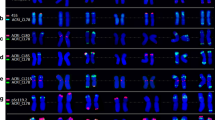Abstract
The grassZingeria biebersteiniana is one of five angiosperms known with 2n=2x=4. Its chromosomes were studied using fluorochrome banding and fluorescencein situ hybridization (FISH). The large pericentromeric region fluoresced much more brightly on chromosome 2 than on chromosome 1, using two different fluorochrome banding methods. These offer rapid and reliable means for identifying chromosomes and work throughout mitosis. FISH located the major site of 18S–26S rDNA sequences at the secondary constriction, which is proximal to two minor sites, all on the short arm of chromosome 1. Two 5S sites were also detected, the most distinct on the short arm of chromosome 2 and the other apparently co-localized with part of the major 18S–26S rDNA cluster on chromosome 1. These results constitute the first steps in constructing a physical gene map forZ. biebersteiniana. Such information may facilitate future studies of the organization and reorganization of grass genomes, including research into the spatial arrangement of the genome inZingeria nuclei and much wider comparisons of synteny and genome evolution in grasses.
Similar content being viewed by others
References
Appels R, Honeycutt RL (1986) rDNA: evolution over a billion years. In: Dutta SK, ed.DNA Systematics. Vol. 2,Plants. Boca Raton: CRC Press, pp 81–135.
Appels R. Gerlach WL, Dennis ES, Swift H, Peacock WJ (1980) Molecular and chromosomal organization of DNA sequences coding for the ribosomal RNAs in cereals.Chromosoma 78: 293–311.
Arrighi FE, Hsu TC (1971) Localization of heterochromatin in human chromosomes.Cytogenetics 10: 81–86.
Bennett MD, Smith JB, Seal AG (1986) The karyotype of the grassZingeria biebersteiniana (2n = 4) by light and electron microscopy.Can J Genet Cytol 28: 554–562.
Bennett ST, Kenton AY, Bennett MD (1992) Genomicin situ hybridization reveals the allopolyploid nature ofMilium montianum (Gramineae).Chromosoma 101: 420–424.
Cox AV, Bennett MD, Dyer TA (1992) Use of the polymerase chain reaction to detect spacer size heterogeneity in plant 5S-rRNA gene clusters and to locate such clusters in wheat (Triticum aestivum L.).Theor Appl Genet 83: 684–690.
Devos KM, Atkinson MD, Chinoy CNet al. (1993) Chromosomal rearrangements in the rye genome relative to wheat.Theor Appl Genet 85: 673–680.
Dvorák J, Zhang H-B, Kota RS, Lassner M (1989) Organization and evolution of the 5S ribosomal RNA gene family in wheat and related species.Genome 32: 1003–1016.
Gerlach WL, Bedbrook JR (1979) Cloning and characterization of ribosomal RNA genes from wheat and barley.Nucleic Acids Res 7: 1869–1885.
Gerlach WL, Dyer TA (1980) Sequence organization of the repeating units in the nucleus of wheat which contain 5S rRNA genes.Nucleic Acids Res 8: 4851–4865.
Ikeda H (1987) Cytogenetic studies on the chromosome complements ofHaplopappus gracilis (2n = 4) andH. ravenii (2n = 8).J Sci Hiroshima Univ, Ser B, Div 2 21: 67–104.
Imai HT, Taylor RW (1989) Chromosomal polymorphisms involving telomere fusion, centromeric inactivation and centromere shift in the antMyrmecia (pilosula) (n = 1).Chromosoma 98: 456–460.
Jackson RC (1973) Chromosomal evolution inHaplopappus gracilis: a centric transposition race.Evolution 27: 243–256.
Jones GH (1978) Giemsa C-banding of rye meiotic chromosomes and the nature of ‘terminal’ chiasmata.Chromosoma 66: 45–57.
Kenton A (1991) Heterochromatin accumulation, disposition and diversity inGibasis karwinskyana (Commelinaceae).Chromosoma 100: 467–478.
Leitch IJ, Heslop-Harrison JS (1992) Physical mapping of the 18S-5.8S-26S rRNA genes in barley byin situ hybridization.Genome 35: 1013–1018.
Leitch IJ, Heslop-Harrison JS (1993) Physical mapping of four sites of 5S rDNA sequences and one site of the α-amylase-2 gene in barley (Hordeum vulgare).Genome 36: 517–523.
Leitch AR, Schwarzacher T, Jackson D, Leitch IJ (1994)In situ hybridization: A practical guide. Royal Microscopical Society, Microscopy Handbooks Vol. 27. Oxford: Bios Ltd.
Lima-de-Faria A (1954) Chromosome gradient and chromosome field inAgapanthus.Chromosoma 6: 330–370.
Maeda N, Smithies O (1986) The evolution of multigene families: human haptoglobin genes.Annu Rev Genet 20: 81–108.
Moore G, Gale MD, Kurata N, Flavell RB (1993) Molecular analysis of small grain cereal genomes: current status and prospects.Bio/Technology 11: 584–589.
Mukai Y, Endo TR, Gill BS (1990) Physical mapping of the 5S rRNA multigene family in common wheat.J Hered 81: 290–295.
Mukai Y, Endo TR, Gill BS (1991) Physical mapping of the 18S.26S rRNA multigene family in common wheat: Identification of a new locus.Chromosoma 100: 71–78.
Schweizer D (1976) Reverse fluorescent chromosome banding with chromomycin and DAPI.Chromosoma 58: 307–324.
Semyonov VI, Semyonova EV (1975) Differential staining of chromosomes ofZingeria biebersteiniana (Claus.) P. Smirn. in mitosis and meiosis (in Russian)Proc Acad Sci Siberia SSSR Biol Sci Ser 3: 80–84.
Stedje B (1988) A new low chromosome number forOrnithogalum tenuifolium (Hyacinthaceae).Pl Sys Evol 161: 65–69.
Stuczynski M (1978)Zingeria beibersteiniana (Claus.) P. Smirn. - gatunek o najmniejszej liczbie chromosomów w rodziniePoaceae.Biuletyn Instytutu Hodowli I Aklimatyzacji Roslin 134: 259–262 (in Polish).
Tsvelev NN, Zhukova PG (1974) On the minimal main chromosome number in the family Poaceae.Bot Z 59: 265–269.
Tutin TG, Heywood VH, Burgess NAet al. (1980)Flora Europaea 5. Cambridge: Cambridge University Press, p 246.
Vosa CG (1976) Heterochromatin classification inVicia faba andScilla sibirica. In: Pearson PL, Lewis KR, eds.Chromosomes Today, Vol 5. New York: John Wiley & Sons, p 185–192.
Watanabe K, Carter CR, Smith-White S (1975) The cytology ofBrachycome lineariloba. 5. Chromosome relationships and phylogeny of the Race A cytodemes (n = 2).Chromosoma 52: 383–397.
Watanabe K, Smith-White S (1987) Phyletic and evolutionary relationships ofBrachyscome lineariloba (Compositae).Pl Syst Evol 157: 121–141.
Whitkus R, Doebley J, Lee M (1992) Comparative genome mapping of sorghum and maize.Genetics 132: 1119–1130.
Yonezawa Y (1981) Cytological and cytogenetic studies on the transposition of centromere and the karyotype differentiation inHaplopappus gracilis.Cytologia 46: 431–441.
Author information
Authors and Affiliations
Rights and permissions
About this article
Cite this article
Bennett, S.T., Leitch, I.J. & Bennett, M.D. Chromosome identification and mapping in the grassZingeria biebersteiniana (2n=4) using fluorochromes. Chromosome Res 3, 101–108 (1995). https://doi.org/10.1007/BF00710670
Received:
Revised:
Accepted:
Issue Date:
DOI: https://doi.org/10.1007/BF00710670




